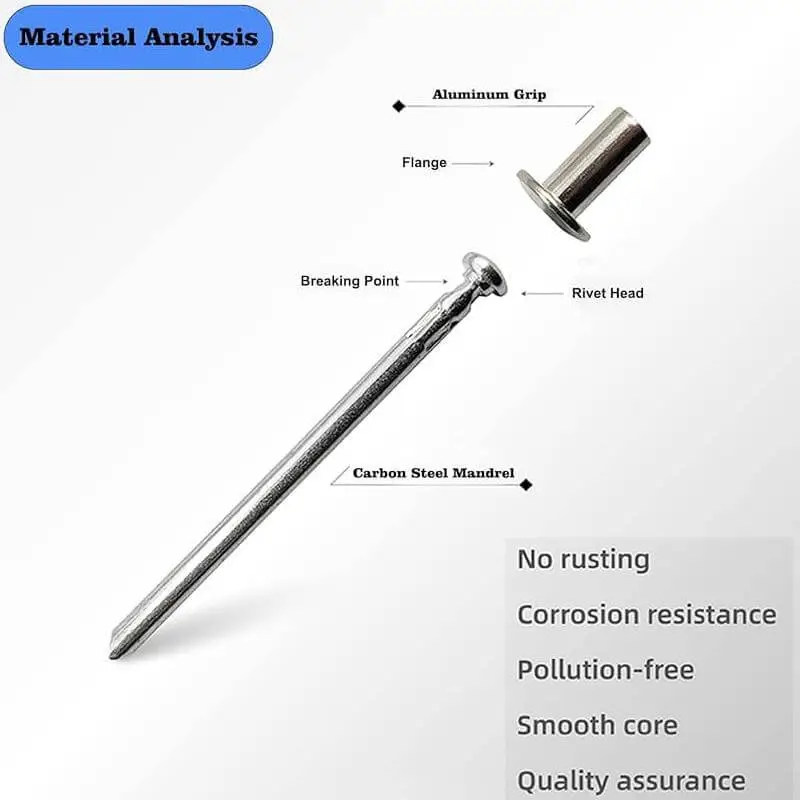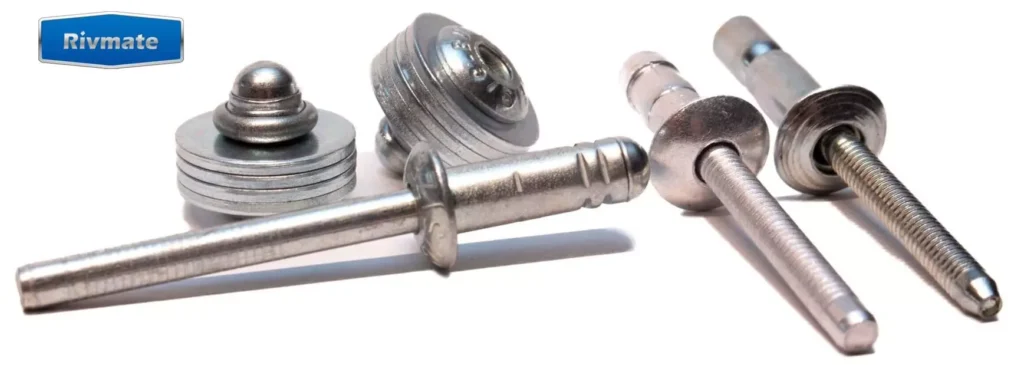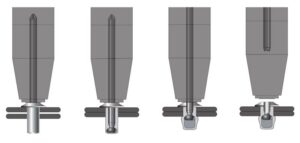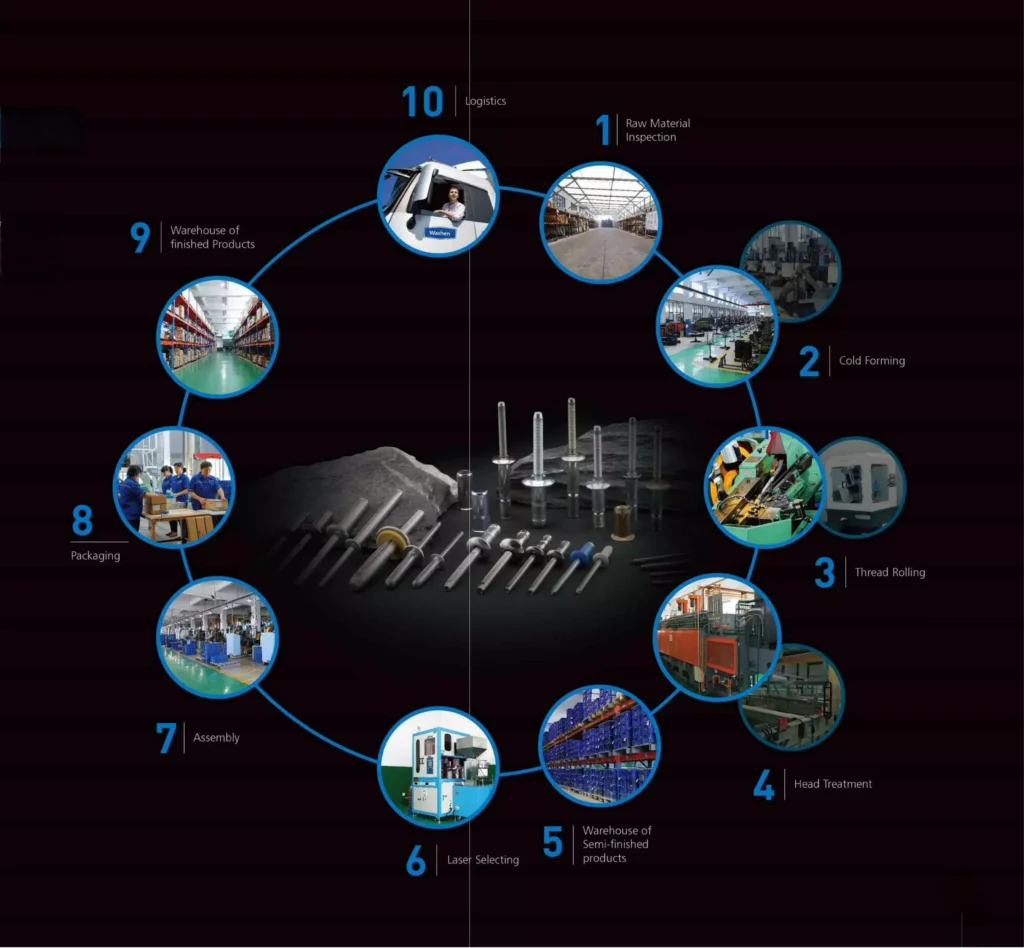Problem with Rivet Mandrel Breaking
Table of Contents
During the installation of blind rivets, “rivet mandrel breaking” is a critical issue that cannot be ignored. The core of the rivet, which is the part that transfers the tension to the cap body, plays a crucial role in the riveting process. It causes the cap body to undergo plastic deformation and secure the workpiece firmly. If the way the core breaks does not meet the design expectations, it may lead to insufficient clamping force. This not only directly affects the mechanical properties of the connection component but also may cause safety hazards and quality complaints.
Rivet mandrels often break during installation. Breakage locations are frequently abnormal. Mandrels may remain inside the rivets. This affects riveting quality and product appearance. Understanding mandrel working principles is essential. Knowing fracture mechanisms helps address the problem. Identifying influencing factors is a key step. These are core paths to improve riveting stability.
Normal Mode and Abnormal Mode of Rivet Mandrel Breakage
In the standard design, the blind rivet mandrel will break at the preset “break point”. This position has been precisely calculated to ensure that the remaining part of the core pin is firmly locked within the rivet cap, thereby guaranteeing the clamping force and connection stability. This normal rivet mandrel breaking mode not only avoids the exposure of the core pin’s remaining part affecting the appearance, but also prevents the deterioration of the rivet performance due to the loosening of the core pin.

However, during actual production and installation processes, core pins often exhibit various abnormal patterns of failure:
- Excessive fracture location: The core pin fractures after the neck groove, resulting in insufficient remaining part and decreased clamping force, and there is a possibility of loosening of the riveting.
- Insufficient fracture location: The core pin fractures before the neck groove, leaving an excessively long exposed core pin, which affects the appearance and may interfere with subsequent assembly.
- Fracture at the middle or tail end of the core pin: This indicates uneven force distribution, core pin quality defect, or abnormal installation tools, which is likely to cause the rivet to fail.
- Core pin pulled out of the cap body: This is usually related to poor neck groove processing, material issues, or excessive installation pulling force, and will directly lead to the loss of connection force.
Main Reasons for Abnormal Rivet Mandrel Breaking
During the use of blind rivets, if the “rivet mandrel breaking” phenomenon occurs abnormally, it is usually caused by the combined effect of multiple factors. Only by accurately identifying the cause can an effective solution be formulated.
1. Quality Issues with Rivet
- Insufficient hardness or excessive brittleness of the core pin material: Insufficient hardness will cause the core pin to undergo plastic deformation during the stretching process, resulting in a shift in the fracture location; excessive brittleness will easily cause brittle fracture at the moment of force application.
- Poor processing of the neck groove (uneven depth, eccentricity): The neck groove is the designed fracture point of the core pin. Uneven processing of the depth will change the force distribution, leading to uncontrollable fracture; eccentric processing will also cause uneven force distribution on the core pin, resulting in premature or delayed fracture.
2. Installation Tool Factors

- Excessive or insufficient pulling force: Excessive pulling force may cause the core pin to break at a position outside the neck groove, while insufficient pulling force may prevent complete breakage, thereby affecting the quality of the riveting.
- Clamp wear and insufficient clamping force leading to sliding core: Insecure clamping may cause the core pin to slide during the stretching process, resulting in abnormal fracture location.
- Improper calibration of pneumatic/electric riveting guns: Failure to set the pulling force value according to the specifications of the rivets will directly lead to abnormal fracture.
3. Structural and Process Factors
- Excessive or insufficient hole diameter: An incorrect hole diameter mismatch will cause abnormal force distribution during the deformation process of the cap body, thereby affecting the fracture location of the core nail.
- Thickness of the connected material exceeds the grip range of the rivet: Insufficient or excessive clamping force will result in a deviation from the designed fracture pattern.
- Limited space at the riveting position causes eccentric force distribution: When riveting in a narrow or irregular space, if the rivet gun and the core nail are not kept coaxial, it will cause the core nail to bend and fracture or undergo irregular damage.
Comparison of Fracture Characteristics of Different Types of Rivet Mandrel Breaking
Different types of blind rivets have distinct characteristics in their core nail fracture patterns, which are closely related to their structural design, core nail material, and tensile strength.
Open-End rivets are mostly used for general structural connections, and the stability of the fracture position depends on the accuracy of the neck groove.
The Closed-End rivets have a sealed cap design, which makes the requirements for the fracture position and remaining length of the core pin more stringent.
Structural Rivet is a type of structural high-strength rivet. Its core pin has high tensile strength and large breaking force. The consistency of fracture directly affects the connection’s load-bearing capacity and fatigue life.
The table below summarizes the typical fracture characteristics, tensile strength requirements, and the standards of Rivmate in the core break consistency test for three types of rivets. It is convenient for engineering technicians to quickly refer to when selecting and controlling quality.
Open-End Vs. Closed-End Vs. Structural Blind Rivet
| Rivet Type | Typical Mandrel Breaking Features | Relationship Between Mandrel Tensile Strength & Breaking Mode | Rivmate Mandrel Consistency Standard |
|---|---|---|---|
| Open-End Blind Rivet | Breaks at designed neck groove, mandrel head remains inside the rivet body; suitable for general applications. | Moderate tensile strength ensures controlled break at groove; too high strength may cause over-pull, too low may cause incomplete break. | 95%+ of samples break within ±0.5 mm of groove position. |
| Closed-End Blind Rivet | Breaks at neck groove with sealed mandrel head inside the closed-end shell; prevents leakage. | Higher tensile strength required due to sealed structure; improper strength may cause premature break or mandrel pull-out. | 98%+ of samples meet design break location with no head extraction. |
| Structural Blind Rivet | Breaks at reinforced groove; mandrel tail locks mechanically inside rivet for high shear/tensile loads. | High tensile strength critical for full clamp-up before break; incorrect strength can reduce structural performance. | 99%+ location consistency; break force deviation ≤ ±5% of spec. |
Rivmate Professional Advice: How to Prevent Abnormal Rivet Mandrel Breaking
When addressing the issue of “rivet mandrel breaking”, prevention is far more efficient and cost-effective than repair. By implementing systematic control in the three aspects of selection, tools, and processes, the probability of abnormal core pin breakage can be significantly reduced, thereby ensuring the quality and structural reliability of the riveting from the very beginning.
Model Selection Optimization
- Select the appropriate clamping range and rod diameter based on plate thickness and load: Ensure that the rivets operate within their designed clamping range to avoid position shift due to insufficient or excessive clamping.
- Give priority to brands that have undergone tensile and core breakage consistency tests (Rivmate standard) : Rivmate conducts ≥95% core breakage position consistency and tensile deviation control tests on each batch of products to ensure batch stability and reduce batch quality risks.
Equipment Maintenance
- Regularly replace the jaw of the puller and inspect the wear of the clamping claws: Worn jaws will reduce the clamping force, causing the core nail to slide or break at an abnormal position.
- Adjust the air pressure or pulling force settings according to the manufacturer’s parameters: Excessive or insufficient settings will alter the force distribution on the core nail. It is necessary to regularly calibrate the riveting tool in accordance with the specifications of the rivets.
Process Control
- Control the aperture tolerance: Ensure that the installation aperture matches the diameter of the rivet to avoid uneven force and abnormal fracture.
- Avoid applying lateral tension when riveting in an inclined or restricted space: Eccentric force can cause the core pin to bend or fracture at an unexpected location.
- Perform trial assembly and tensile testing on critical structures: Conduct sample verification before mass production to ensure that the fracture mode and clamping force comply with the design requirements.
Detection and On-site Investigation Methods for Abnormal Rivet Mandrel Breaking

When dealing with the rivet mandrel breaking anomaly, rapid and accurate detection and troubleshooting are crucial for reducing downtime and lowering rework costs.
Method 1: Using the naked eye or simple magnification for observation, first determine whether the fracture location is within the designed neck groove range. Then, based on the fracture morphology (smooth, torn, bent, etc.), preliminarily classify the causes, such as material issues, insufficient tool clamping, or installation eccentricity, etc.
Method 2: Use a caliper to measure the length deviation of the broken core, and inspect the depth and position of the neck groove, as well as whether there are any processing defects such as eccentricity, cracks, etc. through a microscope or a high-power magnifying glass. At the same time, observe the metallographic features of the fracture surface to determine whether it is a ductile fracture, a brittle fracture, or a mixed mode, so as to correspond to different improvement measures.
Method 3: Use a dedicated tensile testing instrument to measure the output tensile force of pneumatic or electric riveting guns, ensuring that it meets the requirements of the rivet specifications. If the test value deviates significantly from the standard, it should be immediately adjusted or the components (such as the jaws, clamping claws) should be replaced.
Case of On-site Diagnosis Service Provided by Rivmate
At a customer’s site, Rivmate engineers investigated structural rivet breakage issues. Fracture checks, groove measurements, and tensile tests identified the root cause. A larger hole diameter combined with excessive riveting gun air pressure was to blame. Process adjustments and partial rivet specification changes were implemented. Breakage rate dropped from 12% to under 0.5%. Production stability and assembly efficiency improved significantly.
Rivmate Solution and Product Recommendations
Drawing on extensive blind rivet expertise, Rivmate addresses various “rivet mandrel breaking” issues. A diverse product range and tailored services are offered. These help customers achieve consistent core breaking and reliable connections across different assembly environments.
Rivmate High Consistency Broken Core Control Rivet Series
Designed for high-frequency assembly and automated lines, the neck groove accuracy is kept within ±0.02 mm. Each batch undergoes full tensile strength and break position inspections for consistency. Ideal for automotive, appliance, and sheet metal industries with strict rhythm and consistency demands. Helps reduce stoppages and rework from abnormal core breaks.
Special Working Condition Reinforced Core Nail Bolts
For special environments such as Marine, Aerospace, and Heavy Duty, high-strength corrosion-resistant alloy core nail materials are adopted. A stress-relief structure is introduced in the neck groove design to enhance the tensile strength and fatigue life. Even under harsh conditions such as high humidity, high salt spray, vibration, and shock, the core breakage position remains stable and the connection performance remains durable.
Based on the specific rivet model, plate thickness range and assembly cycle of the customers, a customized riveting tensile parameter setting plan is provided, and the optimal clamping system for pneumatic/electric riveting guns is matched. Rivmate engineers can conduct tool calibration and operation training on-site to ensure that the installation tensile force precisely matches the rivet design requirements, thereby reducing the probability of abnormal core breakage from the very beginning.
Case Analysis
Case 1: A shipyard had to rework due to frequent abnormal fractures of the core pins
At a large shipyard, blind rivets in deck hatches often broke outside the neck groove. This caused loose joints and leakage, with rework rates reaching 8%. Rivmate engineers visited the site for investigation. We examined fracture patterns, measured groove dimensions, and tested pull force. Batch material fluctuations and excessive air pressure were identified as causes. High-consistency Rivmate rivets and recalibrated pneumatic gun pressure were introduced. Break positions stabilized within ±0.5 mm after adjustments. Rework rate fell to 0.3%, saving the shipyard significant monthly costs.
Case 2: Upgrading an Electrical Appliance Production Line
After switching to semi-automation, an appliance maker saw rivet breakage rates hit 3%. This hurt both production efficiency and product appearance quality. Rivmate supplied high-consistency rivets with full inspection. Material and tension settings on the automated equipment were also adjusted. Breakage rate quickly dropped to 0.2% after changes. Line stoppages fell by 85%, boosting assembly efficiency. Product consistency and final appearance quality were fully maintained.
Conclusion
Rivet mandrel breaking is not an inevitable defect in riveting. By selecting rivets scientifically, ensure that the clamping range, material strength and application environment are matched. Through rigorous process control, maintain the stability of hole diameter tolerance and installation posture. Combined with regular tool maintenance and calibration. It is possible to significantly reduce the occurrence probability of abnormal breakage, ensuring the long-term stability and safety of the connection structure.

Secure Every Connection with Rivmate Rivets
Rivmate has always been committed to providing customers with full lifecycle riveting quality assurance from product design, production testing to on-site application. Whether it is an automated production line for high-frequency assembly or special working conditions in harsh environments, we can offer high-consistency core-break control rivets, reinforced core-nut solutions, and customized tool matching services. These help customers significantly reduce rework rates, improve assembly efficiency, and achieve lower total cost of ownership.
Reference

How to Rivet Metal to Wood?
How to Rivet Metal to Woo

What Is Riveting in Metal Work?
What Is Riveting in Metal

What Metal Are Rivets Made Of
What Metal Are Rivets Mad

How to Rivet Metal to Metal
How to Rivet Metal to Met





